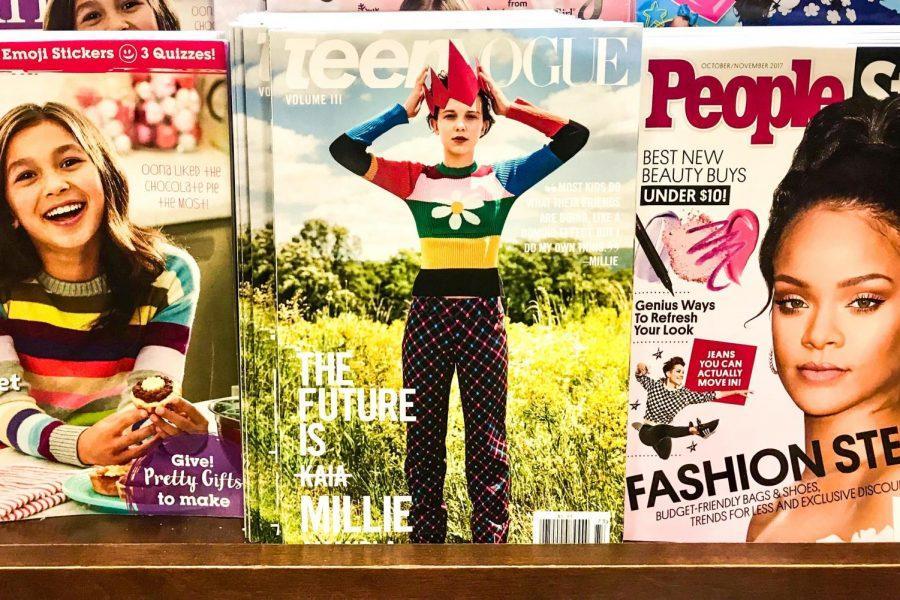Teen Vogue Says Goodbye to Print
Moving to become more digital-oriented and modern, Condé Nast will end Teen Vogue’s print run to reduce its print spending.
November 13, 2017
Disclaimer: Alice Lammers, quoted in the article below, is a contributing writer at Washington Square News.
Condé Nast is slowly moving away from its history of glossy-covered magazines in an effort to become more digitally-oriented and modern. To reduce its print spending, Condé Nast will end Teen Vogue’s print run.
The company wants to evolve its means of content consumption and deliver content that resonates with the cultural movements and platforms important to its audience, according to a statement from Condé Nast. Teen Vogue, which was introduced in 2003, has recently garnered attention for being at the frontlines of news during the 2016 election and providing key information for a younger audience.
Meryl Gordon, director of Magazine Writing at the Arthur L. Carter Journalism Institute and writer for Vanity Fair, the New York Times Book Review and Town and Country, said she was saddened by the news.
“I’m always sad when any print publication ceases to exist,” Gordon said. “I personally love reading physical magazines and I think readers enjoy them. However, we’re in a difficult world and advertising environment, so I can understand why Condé Nast would make this decision.”
Students are affected by this change as well. LS freshman Alice Lammers has always taken a liking to the brand’s ability to bridge fashion and art with important issues affecting teens.
“I remember when I was in elementary school and I started getting my Teen Vogue subscription,” Lammers said. “I’d learned about eating disorders, cyberbullying and many other important topics.”
New life was pumped into the magazine last year by Elaine Welteroth, who was officially named editor-in-chief in the spring of 2016. Welteroth, who is Condé Nast’s youngest editor-in-chief ever, gave many women a platform to not only write about fashion and beauty but to also bridge the importance between news and politics with social justice and intersectionality.
Teen Vogue’s new stride toward becoming a strictly online platform is proof of the company’s confidence in its Digital Editorial Director, Phillip Picardi, a 2012 Gallatin alum. Picardi, 26, is also the digital editorial director of Allure. He is credited for much of Teen Vogue’s recent digital growth and diversity. Most notably, Picardi is the chief operating officer of Them, Condé Nast’s new LGBTQ platform.
The collapse of print magazines is certainly an issue affecting women’s magazines more rapidly than men’s magazines. Magazines like GQ, Sports Illustrated and Maxim continue to make a profit by selling print subscriptions to their faithful readers.
Gordon credits this success of men’s print magazines to their niched quality.
“Magazines targeted toward men are usually beyond the general interest,” Gordon said. “GQ and Esquire are targeted toward sports lovers or people interested in different categories. The number of general interest women’s magazines has been enormous and now, of course, it’s dwindling.”
Many are left wondering if this step away from print will be a good move for Teen Vogue at such a progressive moment for the brand. With its recent success in content creation and audience interaction, we can only hope they won’t lose their winning streak.
Gordon is confident in the legacy of Si Newhouse, Jr., who was Vogue’s publisher for 40 years until his recent death at the age of 89.
“Newhouse, the owner of Condé Nast is obviously a huge factor in what comes ahead because he loved and protected these magazines and put a huge fortune into them,” Gordon said. “What’s interesting about the history of magazines is they’re constantly evolving. I’m sure the next generation will be more conscious of cost than just thinking about the sheer joy of a magazine — they have to be.”
Moving forward, Teen Vogue will have a distinct identity. We can only hope that the brand will continue to create a space for more diverse creators to have a voice in many different forms of art.
It is highly likely that even though the magazine will no longer have a print edition, it will still work its way into the hearts of many and continue to engineer the ideas of many young people of various backgrounds.
“Yeah it’s true we’re all just like bloggers curating our own content, but you could never curate Teen Vogue,” Lammers said. “They’ll always be their own special brand.”
A version of this article appeared in the Monday, Nov. 13 print edition. Email Tianne Johnson at [email protected].

























































































































































